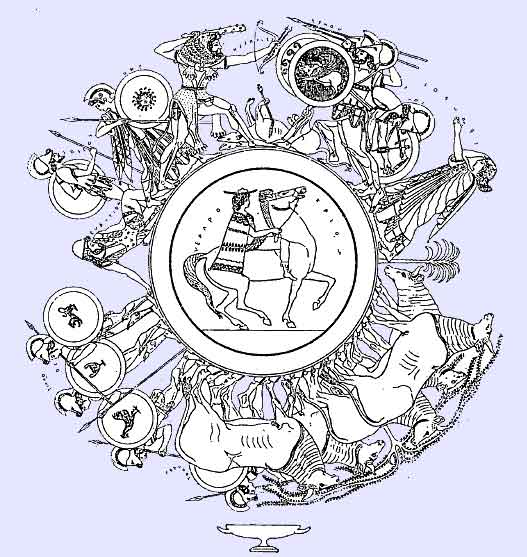
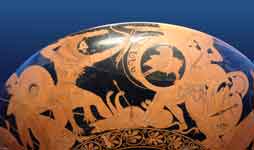
In Greek mythology, Geryon (Γηρυών) or Geryones (Γηρυόνης , Γηρυόνης, son of Chrysaor and Callirhoe, was a winged giant made from three entire human bodies conjoined at the waist. Geryon lived on the island of Erytheia, in the far west of the Mediterranean. He owned a two headed hound, named Orthrus, which was the brother of the Cerberus, and a group of cattle. The cattle were guarded by Orthrus, and a man named Eurythion.
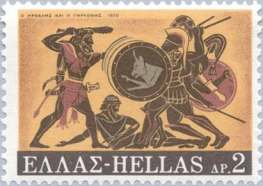
Heracles against Geryon
Heracles' Journey to Erytheia (Location of the Cattle of Geryon)

Heracles in the golden cup of Helios
Heracles was told to obtain the Cattle of Geryon as his tenth labour. While journeying towards there, he crossed the Libyan desert (Libya was the generic name for Africa to the Greeks), and was so frustrated at the heat that he shot an arrow at Helios, the sun. Helios begged him to stop, and Heracles demanded the golden cup used by Helios to sail across the sea each night. Heracles used the cup to reach Erytheia.
Theft of the Cattle of Geryon
Heracles tried to steal the cattle, and killed Orthrus, then Eurythion. Geryon arrives, in some versions due to having been informed of Herakles' actions by Menoetius, Hades' shepherd. Heracles finally kills Geryon, tearing his body into its three pieces.
Heracles then had to herd the cattle back to Eurystheus. On the Aventine hill in Italy, Cacus stole some of the cattle stolen from Geryon as Heracles slept, making the cattle walk backwards so that they left no trail. According to some versions, Heracles drove his remaining cattle past a cave, where Cacus was hiding the stolen ones, and they began calling out to each other, but in others, Caca, Cacus' sister, told Heracles where he was. Heracles then killed Cacus, and according to the Romans, then founded an altar where the Forum Boarium, the cattle market, was later held.
To annoy Heracles, Hera sent a gadfly to bite the cattle, irritate them and scatter them. Hera then sent a flood which rose the water level of a river so much Heracles could not ford the cattle. He piled stones into the river to make the water shallower. Heracles then had to kill a monster that was half-woman and half-serpent. When he finally reached he court of Eurystheus, the cattle were sacrificed to Hera.
The poet Stesichorus wrote a 'song of Geryon' (Geryoneis) in the 6th century BC, which is the best source of this epic, and also contains the first reference to Tartessus.
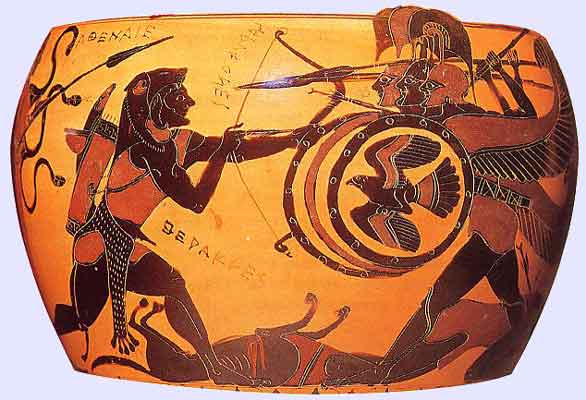
Heracles fighting Geryon (dying Orthrus and Eurytion on the ground). Chalcidian black-figured amphora from South Italy, ca. 540 BC, Inscription Painter
Origin
When the sun reaches the constellation of Gemini, it meets the constellation of Auriga. Many ancient beliefs associated the daily path of the sun across the sky with the sun god using a fiery chariot, and so, here, the sun's yearly path (its transit) obtains the fiery chariot (Auriga) of the sun's daily path. Later Greek mythology considered the sun to use a cup to traverse the sky.
Also in this region of the sky is a vast space without easily visible stars (now occupied by the new constellations of Lynx, and by Camelopardalis), which the ancient Greeks described as a desert. A story based on this region of the sky therefore requires a vast desert, the best know of which to the ancient Greeks was that of Libya. However, even though the deserted area is past much of the constellations, in this region of the sky, setting a story in the desert requires someone to travel through it to the main location. Since Auriga is the nearest constellation from the start of the sun's transit to border on the empty space, a solar-chariot (later adjusted into a cup) becomes the method of traversing the desert.
The milky way was so named by the ancient Greeks because it appears to be a smear of milk across the sky. Some, however, were able to discern some individual stars in the sky, and as such, it became to them a vast herd of cattle, whose milk filled the gaps between them. The star Capella, which is part of Auriga, was known to the Greeks as the Shepherd's star (as some groups considered Auriga to be a shepherd driving a chariot, as well as the chariot, whilst keeping a goat slung over its left shoulder). Capella is very close to, but just outside, the Milky Way, and as such, considered a shepherd, appears to be herding it.
In gemini, the constellation Canis Major (the great dog), sits close to the milky way. The head of the constellation faces away from the sun. However, at the other end of the constellation (where the tail should be) sits the star Sirius, considered evil by many ancient mythologies due to its flickering and redness, which was itself considered a dog (the dog star), by association with the constellation. As such, the constellation has two heads, one is the normal head of the constellation, and the other is Sirius on the other side.
Nearer to the sun than Canis Major, and also appearing to guard the milky way in this area of the sun's transit as well as Canis Major and Capella, is Orion the giant. Traditionally Orion is considered a single giant, but it also equally possible to differentiate it into three separate whole bodies joined at the belt, as Geryon is described, particularly as the legs appear in quite distinct direction, and alternative drawings (taking into account slightly fainter stars than basic diagrams) of the constellation normally depict three rather than two arms, the third and second sharing the same right shoulder.
The sun manages to pass these obstacles, passing through the Milky Way. Auriga appears to be parked in the Milky Way itself, and as such some of the cows of the milky way herd are in it. After the Milky Way, the sun meets Gemini itself. Depictions of Gemini vary as to whether it leans east or west, in the westerly direction it is possible to draw the constellation as two stick man, and Gemini's feet rest in the Milky Way. In the easterly depictions, one of the twins is in the milky way, and the other is outside it, and as such, one twin has stolen some cows, and the other, the one whom the sun's transit crosses, has not. In the myth of Castor and Pollux (the usual names of the twins in gemini), their deaths are due to an argument over the theft of cattle.
Below Gemini, lies the constellation Hydra (the Greeks not acknowledging the existence of Canis Minor, for which Crater acts as a partial head.
Chthonic associations
Geryon is sometimes identified as a chthonic death-demon, mainly because of the association with the extreme western direction. For instance, in Dante's Divine Comedy Geryon is a beast that dwells in phlegethon with the tail of a scorpian but face of an honest man at the edge of the Seventh Circle (the circle of violence) descending into hell. He marks the passage to the Eight Circle as he bathes at the edge of the abyss in Cocytus.
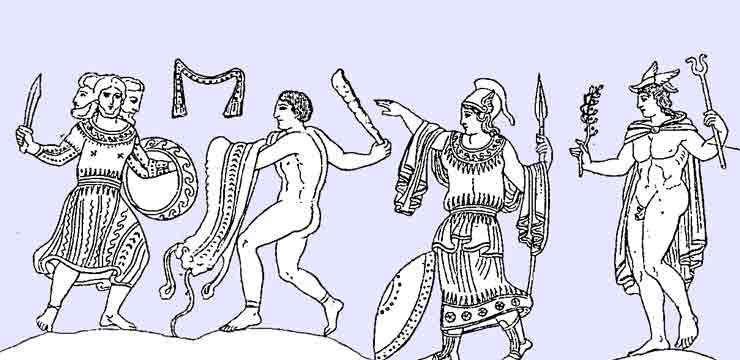
Geryon, Heracles using his lion skin as a shield, Athena and Hermes, vase painting
Further reading
- M. M. Davies, Stesichoros' Geryoneis and its folk-tale origins. Classical quarterly NS 38, 1988, 277-290.
- Anne Carson, Autobiography of Red. New York: Vintage Books, 1998. A modern retelling of Stesichoros' fragments.
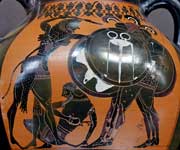
Heracles and Geryon, Louvre F55

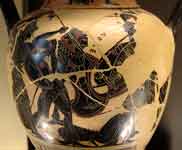
Heracles and Geryon Louvre F115
Heracles and Geryon. Side A from an Attic black-figure amphora, ca. 540 BC
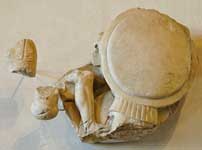
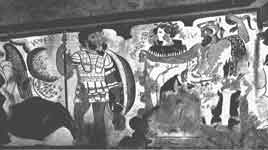
Geryon with Hades and Persephone, Dell'Orco Tomb, Etruscan painting
Retrieved from "http://en.wikipedia.org/"
All text is available under the terms of the GNU Free Documentation License
| Ancient Greece
Science, Technology , Medicine , Warfare, , Biographies , Life , Cities/Places/Maps , Arts , Literature , Philosophy ,Olympics, Mythology , History , Images Medieval Greece / Byzantine Empire Science, Technology, Arts, , Warfare , Literature, Biographies, Icons, History Modern Greece Cities, Islands, Regions, Fauna/Flora ,Biographies , History , Warfare, Science/Technology, Literature, Music , Arts , Film/Actors , Sport , Fashion --- |

